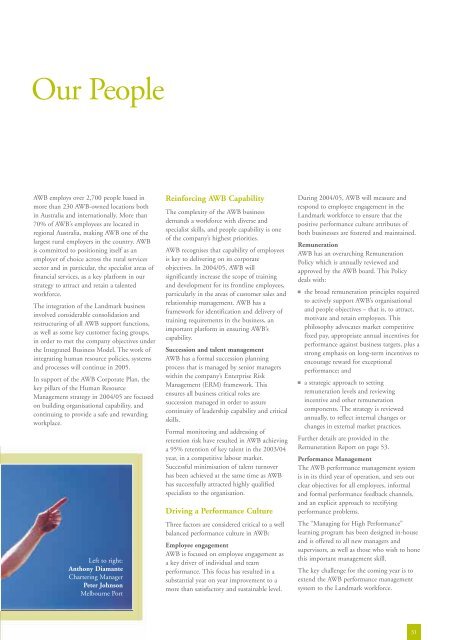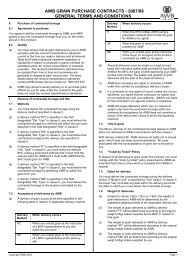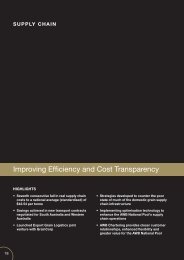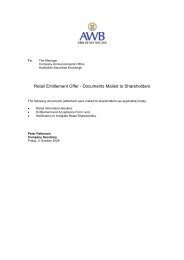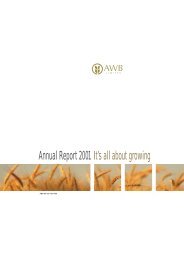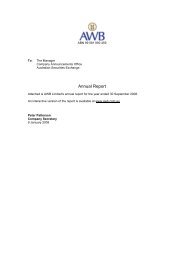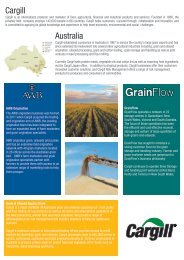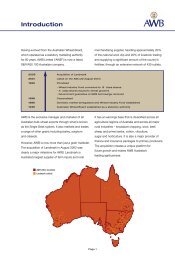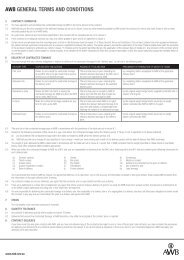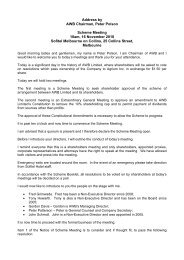AWB Limited - 2004 Annual Report
AWB Limited - 2004 Annual Report
AWB Limited - 2004 Annual Report
You also want an ePaper? Increase the reach of your titles
YUMPU automatically turns print PDFs into web optimized ePapers that Google loves.
Our People<br />
<strong>AWB</strong> employs over 2,700 people based in<br />
more than 230 <strong>AWB</strong>-owned locations both<br />
in Australia and internationally. More than<br />
70% of <strong>AWB</strong>’s employees are located in<br />
regional Australia, making <strong>AWB</strong> one of the<br />
largest rural employers in the country. <strong>AWB</strong><br />
is committed to positioning itself as an<br />
employer of choice across the rural services<br />
sector and in particular, the specialist areas of<br />
financial services, as a key platform in our<br />
strategy to attract and retain a talented<br />
workforce. <br />
The integration of the Landmark business<br />
involved considerable consolidation and<br />
restructuring of all <strong>AWB</strong> support functions,<br />
as well as some key customer facing groups,<br />
in order to met the company objectives under<br />
the Integrated Business Model. The work of<br />
integrating human resource policies, systems<br />
and processes will continue in 2005. <br />
In support of the <strong>AWB</strong> Corporate Plan, the<br />
key pillars of the Human Resource<br />
Management strategy in <strong>2004</strong>/05 are focused<br />
on building organisational capability, and<br />
continuing to provide a safe and rewarding<br />
workplace.<br />
Left to right:<br />
Anthony Diamante<br />
Chartering Manager<br />
Peter Johnson<br />
Melbourne Port<br />
Reinforcing <strong>AWB</strong> Capability<br />
The complexity of the <strong>AWB</strong> business<br />
demands a workforce with diverse and<br />
specialist skills, and people capability is one<br />
of the company’s highest priorities.<br />
<strong>AWB</strong> recognises that capability of employees<br />
is key to delivering on its corporate<br />
objectives. In <strong>2004</strong>/05, <strong>AWB</strong> will<br />
significantly increase the scope of training<br />
and development for its frontline employees,<br />
particularly in the areas of customer sales and<br />
relationship management. <strong>AWB</strong> has a<br />
framework for identification and delivery of<br />
training requirements in the business, an<br />
important platform in ensuring <strong>AWB</strong>’s<br />
capability.<br />
Succession and talent management<br />
<strong>AWB</strong> has a formal succession planning<br />
process that is managed by senior managers<br />
within the company’s Enterprise Risk<br />
Management (ERM) framework. This<br />
ensures all business critical roles are<br />
succession managed in order to assure<br />
continuity of leadership capability and critical<br />
skills.<br />
Formal monitoring and addressing of<br />
retention risk have resulted in <strong>AWB</strong> achieving<br />
a 95% retention of key talent in the 2003/04<br />
year, in a competitive labour market.<br />
Successful minimisation of talent turnover<br />
has been achieved at the same time as <strong>AWB</strong><br />
has successfully attracted highly qualified<br />
specialists to the organisation.<br />
Driving a Performance Culture<br />
Three factors are considered critical to a well<br />
balanced performance culture in <strong>AWB</strong>:<br />
Employee engagement<br />
<strong>AWB</strong> is focused on employee engagement as<br />
a key driver of individual and team<br />
performance. This focus has resulted in a<br />
substantial year on year improvement to a<br />
more than satisfactory and sustainable level.<br />
During <strong>2004</strong>/05, <strong>AWB</strong> will measure and<br />
respond to employee engagement in the<br />
Landmark workforce to ensure that the<br />
positive performance culture attributes of<br />
both businesses are fostered and maintained.<br />
Remuneration<br />
<strong>AWB</strong> has an overarching Remuneration<br />
Policy which is annually reviewed and<br />
approved by the <strong>AWB</strong> board. This Policy<br />
deals with:<br />
the broad remuneration principles required<br />
to actively support <strong>AWB</strong>’s organisational<br />
and people objectives – that is, to attract,<br />
motivate and retain employees. This<br />
philosophy advocates market competitive<br />
fixed pay, appropriate annual incentives for<br />
performance against business targets, plus a<br />
strong emphasis on long-term incentives to<br />
encourage reward for exceptional<br />
performance; and<br />
a strategic approach to setting<br />
remuneration levels and reviewing<br />
incentive and other remuneration<br />
components. The strategy is reviewed<br />
annually, to reflect internal changes or<br />
changes in external market practices.<br />
Further details are provided in the<br />
Remuneration <strong>Report</strong> on page 53.<br />
Performance Management<br />
The <strong>AWB</strong> performance management system<br />
is in its third year of operation, and sets out<br />
clear objectives for all employees, informal<br />
and formal performance feedback channels,<br />
and an explicit approach to rectifying<br />
performance problems.<br />
The “Managing for High Performance”<br />
learning program has been designed in-house<br />
and is offered to all new managers and<br />
supervisors, as well as those who wish to hone<br />
this important management skill.<br />
The key challenge for the coming year is to<br />
extend the <strong>AWB</strong> performance management<br />
system to the Landmark workforce.<br />
31


